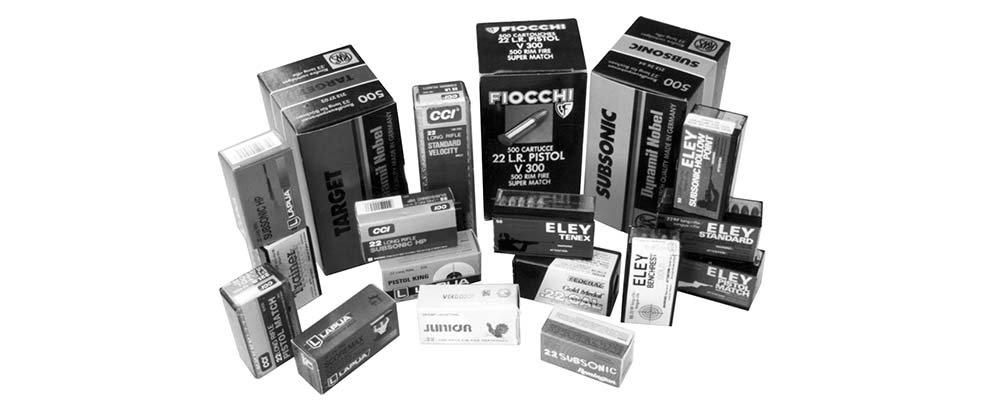By Steve Baughman
Several fellow shooters within my circle of friends are connoisseurs of the .22 caliber suppressor. They like quiet guns. And the ability to discretely target shoot between trips out with the machine guns helps quench that need to shoot on a daily or weekly basis. With fewer and fewer areas available for shooting these days, a quiet .22 allows one to shoot in areas that would otherwise be unavailable. Most folks I know shoot removable muzzle cans on their rifles, while others utilize a permanently attached suppressor to the barrel as offered by several suppressor manufacturers. One of the major benefits of the screw-on muzzle can over the integral type is that the barrel produces higher velocities than are produced by a ported barrel, utilizing the same type of ammo. Additionally, the muzzle can is adaptable to both a rifle and a pistol, which gives the shooter twice the capability for the $200 tax paid on the suppressor. A disadvantage of a muzzle can (if there is one) is that the user must select the optimal ammunition to be suited to the particular task at hand. If one utilizes an integral type of suppressor, higher velocity ammunition can be used, since its velocity will be bled-off to subsonic levels to achieve quiet operation. This project started out as our own “need to know” type of endeavor for the muzzle can user. It soon expanded into an exhaustive evaluation. With all the different ammunition out there, we wanted to optimize our firearm to one or two particular rounds. This article will give an account of what we discovered.
Learning to master the discipline of superior marksmanship, and determining what the maximum performance that your firearm is capable of, can be a very satisfying avocation, which may take a lifetime attempting to master. The use of a suppressor can help in allowing one to safely and economically fire thousands of rounds a year. You can target shoot and practice often, without traveling to distant ranges or hunting grounds. Whether used for target shooting, pest elimination, hunting (where allowed by law), or general skill improvement, the suppressor and an accurate .22 rifle is a versatile tool. The low discharge sound and negligible recoil makes shooting a flinch-free endeavor. All sports require frequent practice, and the suppressed gun can be used to teach the elements of marksmanship which carry over to almost all firearms shooting. The rigors of special licensing, fingerprinting, background checks, and a one time $200 tax payment is usually enough to keep many folks from obtaining a suppressor, but it is possible for those who qualify. The use of a suppressor for hunting is illegal in most states. However, it is legal for pest elimination and target shooting. With less area available for shooting these days, a “quieter” .22 allows one to shoot in areas which would otherwise be unavailable.
Once the muzzle-can suppressed rifle is obtained, those interested in both accuracy and silence will need to confine their ammunition selection to target or subsonic rounds. Most accurate .22LR subsonic ammunition is usually loaded to provide a bullet velocity of around 1040-1050 fps, when fired from a rifle. This particular loading allows accurate performance, and is usually subsonic unless one is shooting in extremely cold weather. Hypersonic, or high velocity rimfire rounds will have a velocity from 1200-1600 fps, which is faster than the speed of sound, hence producing a ballistic crack. The bullet’s ballistic crack is similar to the sonic boom produced by an airplane as it flies faster than the speed of sound. The measured speed of sound in air at 32(F is around 1087 fps. At 68(F, the speed of sound increases to around 1126 fps. Atmospheric pressure, altitude, and humidity play very minor parts in the equation. Temperature is the primary factor in determining the speed of sound. Mathematically speaking, the speed of sound in air (feet per second) at atmospheric temperature is defined in Table 1.
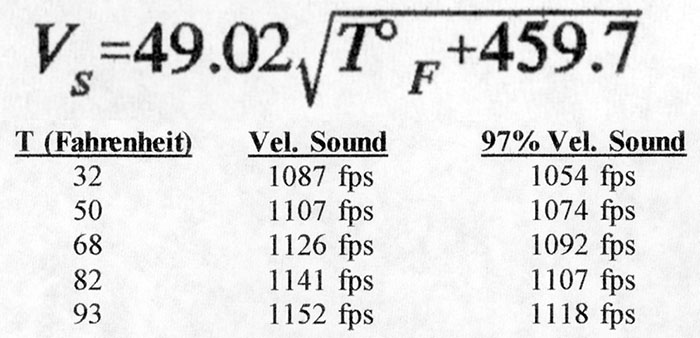
Since the speed of sound increases with higher temperatures, this phenomenon may allow the shooter to “get away with” shooting higher velocity rounds in warm weather without the bullet breaking the sound barrier. The speed of sound is slower in cold weather, however bullets usually exit faster, because warmer powder burns faster. My experience has shown that as long as the bullet’s muzzle velocity is less than 97% of the speed of sound at any given temperature, it’ll be completely subsonic, and the report will be quiet. Supersonic ammo fired from a suppressed rifle will literally “wake the dead” in comparison. Consequently, firing a supersonic projectile from a muzzle can suppressed rifle will negate most of the benefits of the suppressor, as the ballistic crack from the bullet flight will be heard.

The test platform for our evaluation was a Ruger 77/22 rifle which was modified with a sound suppressor manufactured by Mark White of Sound Technology (P.O. Box 391, Pelham, AL 35124 – phone 205-664-5860). With the exception of the suppressor and a Volquartzen target sear, the 77/22 was stock. Velocities were measured using a ProChrono chronograph with the start screen placed 6 feet in front of the muzzle. Each brand of ammunition was evaluated for accuracy, velocity, extreme spread, cost, and bullet weight. Accuracy results were based on five, five-shot groupings at 50 yards. The same type of target was utilized for all testing with accuracy data based on center-to-center measurements using a digital caliper.
Our search for accurate and quiet .22 LR ammo started with the economically priced Russian Jr-Brass and CCI Standard Velocity. It soon escalated up the price range to the Federal Ultra Match which run somewhere around 20 cents/round. I personally find it very difficult to pay a lot for 22 ammo. I’ve spent too many years shooting for around a penny or two a round, and it really gets to me to have to pay the high price for match-grade ammo. If it was not for my desire to “know how much you get for what you pay for”, and for the benefit of completing this article, I would not get caught dead paying 20 cents/round for 22 LR ammo. I know there are those who pay for this kind of performance, so some of these rounds are included in the evaluation. The extreme spread (lowest velocity subtracted from the highest) is also important and must be consistent for maximum accuracy at longer distances as it will affect bullet drop and trajectory.
On the subject of having fewer places to shoot these days, if one’s back yard is wooded and happens to be in a moderately unpopulated area, one can set up a “quiet” shooting range. Use earthen backstops behind targets to allow the bullets to be captured for obvious safety reasons. This cuts down on the bullets impact noise which can be very loud when compared to the report of the weapon. A small shooting bench can also be constructed for a few dollars, and in conjunction with either sandbags or a rifle holding device, will help you to extract decent accuracy out of your particular firearm. The target holders should be able to hold paper targets at the top and bottom to cut down on the bullets impact noise. We tried cardboard and plastic type materials to attach our targets to, and they always added to the noise levels due to the bullet’s impact on the surface of the target holder. Of course, the usual fun targets associated with plinking (rocks, tin cans, water, etc.) all negate the quietness of the suppressor as the bullets impact on these is far noisier than the report of the firearm itself. For the pest eliminator though, the quiet “thud” of the round hitting the varmint is all that is heard.
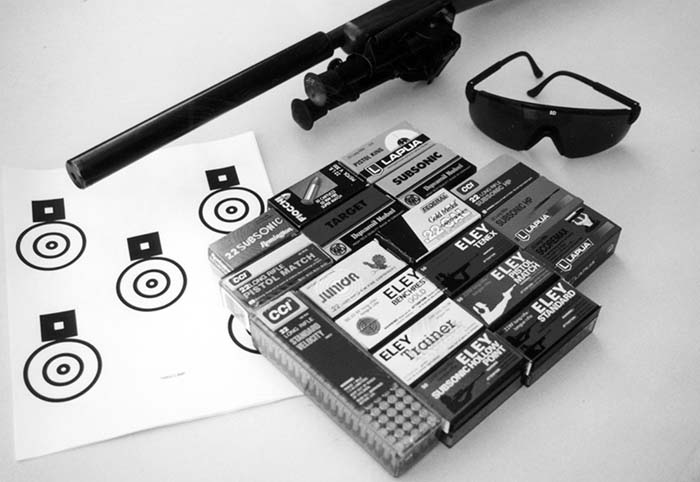
The goal was to decide which particular ammo brand would be best suited for the suppressed rifle. Of course, our data should be used only as a guide as other firearms may perform better or worse than ours did. Topped off with a Tasco 3-9x40TR scope, previous experience with the 77/22’s baseline accuracy proved that the gun was capable of averaging 3/4-inch groups at 50 yards. After being modified with the sound suppressor, the smallest 50 yard grouping came in at .28 inches with RWS subsonic. Other small groups were generated by Lapua Pistol King (.29 inches), Eley Bench Rest Gold (.32 inches) and Fiocchi 300 (.32 inches). The ultra match type ammo cost is a little high for most 22 shooters, but some of this ammo was very accurate. CCI Pistol Match was the overall winner in the more moderately priced category. At around 3 cents/round, Jr-Brass and CCI Standard are pretty tough to beat. Jr-Brass sometimes went supersonic during our colder weather testing. The ballistic crack of the projectile breaking the sound barrier really woke us up. The best overall average accuracy results went to Lapua Pistol King, with Eley Bench Rest Gold, Federal Ultra Match, and Eley Tenex close behind. Overall, there were no losers in this exercise, with the exception of Remington Subsonic. This particular round failed to achieve acceptable results in our testing. Lapua Scoremax delivered very good results with the 48 grain bullet weight. Apparently, the 77/22 testbed really liked this heavier bullet, as it delivered an accuracy average of .57 inches at 50 yards.CCI (Blount), Keng’s Firearms (Lapua), and Federal graciously provided us with some sample ammunition and technical support for this article. CCI provided us with a special Subsonic HP round which is not available here in the United States. Being designated only for export to European countries at this time (where the use of sound suppressors is more widespread), this was a good performer in our tests. Utilizing a 36 grain hollow point bullet, it was both accurate and quiet. I liked the hollow point design, and would recommend that all who are interested contact the folks at CCI and ask that their marketing people provide this round to American shooters.
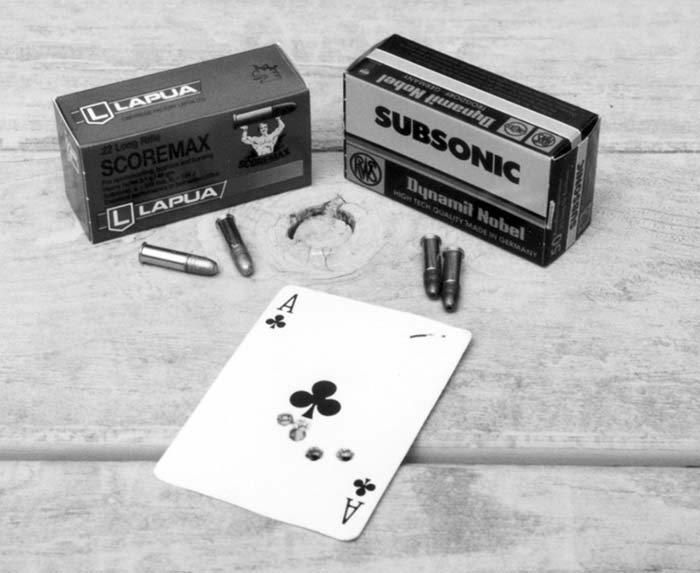
I’m sure this round would be comparable in price to their other offerings. Federal UltraMatch (1000B) was also provided for our testing endeavors. The 1000B is loaded similarly to the Federal round which won the gold and silver medals in the 1992 Olympics, held in Barcelona, Spain. Utilizing a 40 grain solid bullet, the 1000B is loaded for a velocity of 1080 fps, but our measured velocities were a little higher than that. The largest .22LR weight bullet available is the 48 grain Lapua Scoremax. Most of the .22LR bullets weighed in at 40 grains.
In flight, the subsonic projectile has a tremendous arc in its trajectory. This arc makes it critical to correctly measure or estimate distance to the target. At the longer ranges, a small miscalculation of distance of only a few yards can result in a miss. Once you zero in on the particular round which best suits your requirements, a good way to compensate for bullet drop at different differences is to utilize a good scope with a bullet drop compensator elevation ring. The typical elevation ring will need to be dialed to the correct distance, especially with subsonic ammo. To accomplish this with the slower moving subsonic ammo, my procedure involves placing white tape around the elevation ring and marking the tape after zeroing the scope to each distance. This involves placing your zeroing targets at the various distances you want to shoot, and then dialing in your scope at those distances and marking the tape so you can return to the correct position depending upon what distance you’re shooting at. This procedure also helps one estimate target distances more accurately. I usually zero my scope at 25, 50, 75, 100, and 125 yards and place a mark on the elevation ring for each of these distances. It’s best to use the same type of ammo to alleviate the differences due to changes in velocity and brands, as it has a tremendous impact on bullet drop at the longer ranges. The results of our testing has proven my particular 77/22 to be most accurate with the Lapua Pistol King subsonic ammunition. My favorite pick for precision work on varmints with this gun is the RWS Subsonic for its quiet delivery and hollow point design. For economical plinking, the CCI Standard velocity is my favorite for its price, cleanliness, and performance. Hopefully the manufacturers will continue to produce good quality subsonic ammunition for a long time. The heavier Lapua Scoremax also rates up there with my favorites and should provide maximum terminal ballistics, due to its larger mass.
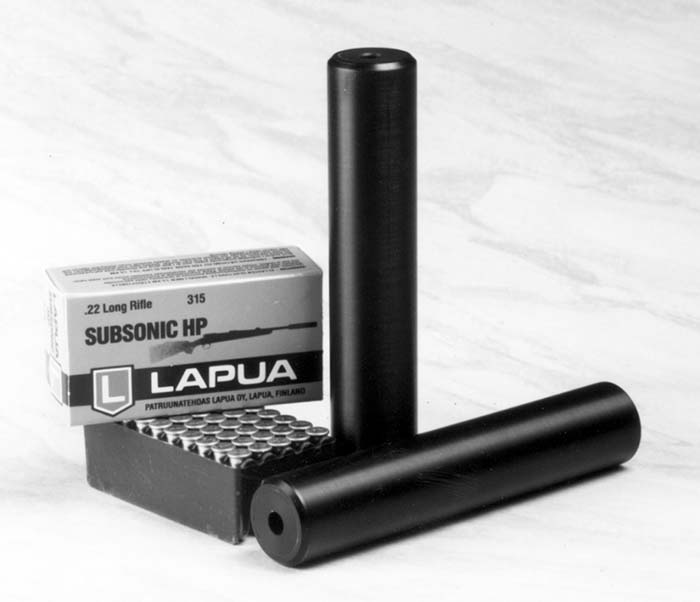
Every shooter should obtain a brick or two of ultra-accurate rounds to help determine just what their gun is capable of. Use the cheaper mid-grade rounds for practice. Always use the most accurate rounds you can afford for hunting or pest elimination. After running around the woods for 2 hours, and stalking for 30 minutes, you won’t believe it’s cost effective if your target is spooked by a single missed shot, caused by a cheaper bullet. I shoot into various targets at different ranges to learn how well different brands penetrate and expand. There is no substitute for this type of personal testing. It will quickly lead to the selection of the most effective round for your own particular use, and will allow you the opportunity to develop the shooting discipline discussed earlier. Hopefully the results of our testing will allow you to select the best combination of ammunition for your particular needs. While not as important for the casual plinker, the animal control officer, competition target shooter, and serious varmint hunter needs to select the best ammunition for the job at hand.
An acquaintance of mine has a vast collection of high quality and expensive rifles he never shoots. Many of them have never been fired at all. He researches and carefully selects his firearms for his perceived needs. However, I know he will probably never get out into the field and shoot these fine guns and determine which ammo works best, or even find out if the guns work at all. As Mr.Kokalis said in a previous interview: “Number one, because to be proficient in anything, including shooting, you have to practice.” Although for different subject matter, this point was also addressed by Carlos Hathcock: “Discipline and training are the keys, and you have to keep shooting and practicing all the time, or you will loose the skills that you need, the ones that will keep you alive.” In other words, keep practicing to stay proficient with your shooting skills. Mental discipline is also required to make that accurate shot. A good friend of mine is a sniper on my local Sheriff’s Office Tactical Team. He trains constantly developing his shooting skills and mental discipline. His departments budget does not allow him to shoot Federal Premium .308 ammo all day long, but he shoots weekly with a muzzle can attached to his favorite .22 rifle to help develop the mental discipline for accurate shooting. If called to carry out his duty as a sniper, its the first shot that must count. If that first shot fails to hit its mark, the results can cost the lives of others. That’s the bottom line.
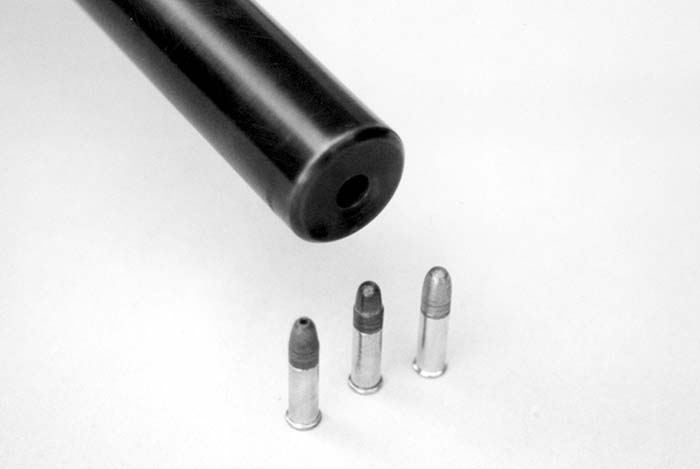
I routinely shoot around 50 rounds per day off the back porch to stay proficient. As for my neighbors, they never hear a thing. I’ll set a few eggs off to the side of the barn on mornings after raiding the hen house. They make excellent targets at 100 yards with RWS Subsonic ammunition and the quiet .22 rifle. I’ll also set empty 12 gage shotgun shells on the sloped side behind the barn and pick them off at a distance of 100-125 yards. Since modifying the 77/22, I’ve never heard a word of complaint from my neighbors.
Sources:
Lapua
Imported by: Keng’s Fire-
arms Specialty
875 Wharton Drive
Atlanta, GA 30336
CCI
Blount, Inc.
2299 Snake River Avenue
PO Box 856
Lewiston, ID 83501
Federal Cartridge Company
900 Ehlen Drive
Anoka, Minnesota 55303
Fiocchi USA
5030 Fremont Road
Ozark, MO
Eley
Imported by: Tomart Inc.
122 Lafayette Avenue
Laurel, MD 20725
RWS
Dynamit Nobel-RWS, Inc.
81 Ruckman Road
Closter, New Jersey 07624
Remington Arms Company
Ilion, New York 13357
| This article first appeared in Small Arms Review V1N3 (December 1997) |



